本教程有对应的视频配套学习,需要的同学可以添加我的微信coderwhy002(有其他任何一个微信都可以)
一. Options API
1.1. computed
1.1.1. 认识计算属性computed
我们知道,在模板中可以直接通过插值语法显示一些data中的数据。
但是在某些情况,我们可能需要对数据进行一些转化后再显示,或者需要将多个数据结合起来进行显示;
-
比如我们需要对多个data数据进行运算、三元运算符来决定结果、数据进行某种转化后显示;
-
在模板中使用表达式,可以非常方便的实现,但是设计它们的初衷是用于简单的运算;
-
在模板中放入太多的逻辑会让模板过重和难以维护;
-
并且如果多个地方都使用到,那么会有大量重复的代码;
我们有没有什么方法可以将逻辑抽离出去呢?
-
可以,其中一种方式就是将逻辑抽取到一个method中,放到methods的options中; -
但是,这种做法有一个直观的弊端,就是所有的data使用过程都会变成了一个方法的调用; -
另外一种方式就是使用计算属性computed;
什么是计算属性呢?
-
官方并没有给出直接的概念解释; -
而是说:对于任何包含响应式数据的复杂逻辑,你都应该使用计算属性; -
计算属性将被混入到组件实例中。所有 getter 和 setter 的 this上下文自动地绑定为组件实例;
那接下来我们通过案例来理解一下这个计算属性。
1.1.2. 计算属性的基本使用
计算属性的用法:
-
**选项:**computed
-
类型: { [key: string]: Function | { get: Function, set: Function } }
我们来看三个案例:
-
我们有两个变量:firstName和lastName,希望它们拼接之后在界面上显示; -
我们有一个分数:score -
当score大于60的时候,在界面上显示及格; -
当score小于60的时候,在界面上显示不及格; -
我们有一个变量message,记录一段文字:比如Hello World -
某些情况下我们是直接显示这段文字; -
某些情况下我们需要对这段文字进行反转;
我们可以有三种实现思路:
-
思路一:在模板语法中直接使用表达式; -
思路二:使用method对逻辑进行抽取; -
思路三:使用计算属性computed;
思路一的实现:模板语法
-
缺点一:模板中存在大量的复杂逻辑,不便于维护(模板中表达式的初衷是用于简单的计算); -
缺点二:当有多次一样的逻辑时,存在重复的代码; -
缺点三:多次使用的时候,很多运算也需要多次执行,没有缓存;
<template id="my-app">
<!-- 1.实现思路一: -->
<h2>{{ firstName + lastName }}</h2>
<h2>{{ score >= 60 ? "及格": "不及格" }}</h2>
<h2>{{ message.split("").reverse().join(" ") }}</h2>
</template>
思路二的实现:method实现
-
缺点一:我们事实上先显示的是一个结果,但是都变成了一种方法的调用; -
缺点二:多次使用方法的时候,没有缓存,也需要多次计算;
<!-- 2.实现思路二: -->
<template id="my-app">
<h2>{{ getFullName()}}</h2>
<h2>{{ getResult() }}</h2>
<h2>{{ getReverseMessage() }}</h2>
</template>
<script src="../js/vue.js"></script>
<script>
const App = {
template: '#my-app',
data() {
return {
firstName: "Kobe",
lastName: "Bryant",
score: 80,
message: "Hello World"
}
},
methods: {
getFullName() {
return this.firstName + " " + this.lastName;
},
getResult() {
return this.score >= 60 ? "及格": "不及格";
},
getReverseMessage() {
return this.message.split(" ").reverse().join(" ");
}
}
}
Vue.createApp(App).mount('#app');
</script>
思路三的实现:computed实现
-
注意:计算属性看起来像是一个函数,但是我们在使用的时候不需要加(),这个后面讲setter和getter时会讲到;
-
我们会发现无论是直观上,还是效果上计算属性都是更好的选择;
-
并且计算属性是有缓存的;
<!-- 3.实现思路三: -->
<template id="my-app">
<h2>{{ fullName }}</h2>
<h2>{{ result }}</h2>
<h2>{{ reverseMessage }}</h2>
</template>
<script src="../js/vue.js"></script>
<script>
const App = {
template: '#my-app',
data() {
return {
firstName: "Kobe",
lastName: "Bryant",
score: 80,
message: "Hello World"
}
},
computed: {
fullName() {
return this.firstName + this.lastName;
},
result() {
return this.score >= 60 ? "及格": "不及格";
},
reverseMessage() {
return this.message.split(" ").reverse().join(" ");
}
}
}
Vue.createApp(App).mount('#app');
</script>
1.1.3. 计算属性 vs methods
在上面的实现思路中,我们会发现计算属性和methods的实现看起来是差别是不大的,而且我们多次提到计算属性有缓存。
接下来我们来看一下同一个计算多次使用,计算属性和methods的差异:
<div id="app"></div>
<template id="my-app">
<!-- 1.使用methods -->
<h2>{{getResult()}}</h2>
<h2>{{getResult()}}</h2>
<h2>{{getResult()}}</h2>
<!-- 2.使用computed -->
<h2>{{result}}</h2>
<h2>{{result}}</h2>
<h2>{{result}}</h2>
</template>
<script src="../js/vue.js"></script>
<script>
const App = {
template: '#my-app',
data() {
return {
score: 90
}
},
computed: {
result() {
console.log("调用了计算属性result的getter");
return this.score >= 60 ? "及格": "不及格";
}
},
methods: {
getResult() {
console.log("调用了getResult方法");
return this.score >= 60 ? "及格": "不及格";
}
}
}
Vue.createApp(App).mount('#app');
</script>
打印结果如下:
-
我们会发现methods在多次使用时,会调用多次; -
而计算属性虽然使用了三次,但是计算的过程只调用了一次;

这是什么原因呢?
-
这是因为计算属性会基于它们的依赖关系进行缓存; -
在数据不发生变化时,计算属性是不需要重新计算的; -
但是如果依赖的数据发生变化,在使用时,计算属性依然会重新进行计算;
<template id="my-app">
<input type="text" v-model="score">
<!-- 省略代码 -->
</template>
<script src="../js/vue.js"></script>
<script>
const App = {
template: '#my-app',
data() {
return {
score: 90
}
},
// 省略代码
}
Vue.createApp(App).mount('#app');
</script>
我们来看一下当分数变化时,方法和计算属性的反应:
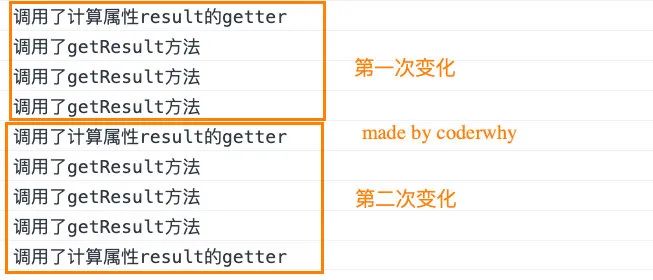
1.1.4. 计算属性的setter和getter
计算属性在大多数情况下,只需要一个getter方法即可,所以我们会将计算属性直接写成一个函数。
但是,如果我们确实想设置计算属性的值呢?
-
这个时候我们也可以给计算属性设置一个setter的方法;
<template id="my-app">
<h2>{{fullName}}</h2>
<button @click="setNewName">设置新名字</button>
</template>
<script src="../js/vue.js"></script>
<script>
const App = {
template: '#my-app',
data() {
return {
firstName: "Kobe",
lastName: "Bryant"
}
},
computed: {
fullName: {
get() {
return this.firstName + " " + this.lastName;
},
set(value) {
const names = value.split(" ");
this.firstName = names[0];
this.lastName = names[1];
}
}
},
methods: {
setNewName() {
this.fullName = "coder why";
}
}
}
Vue.createApp(App).mount('#app');
</script>
你可能觉得很奇怪,Vue内部是如何对我们传入的是一个getter,还是说是一个包含setter和getter的对象进行处理的呢?
-
事实上非常的简单,Vue源码内部只是做了一个逻辑判断而已;
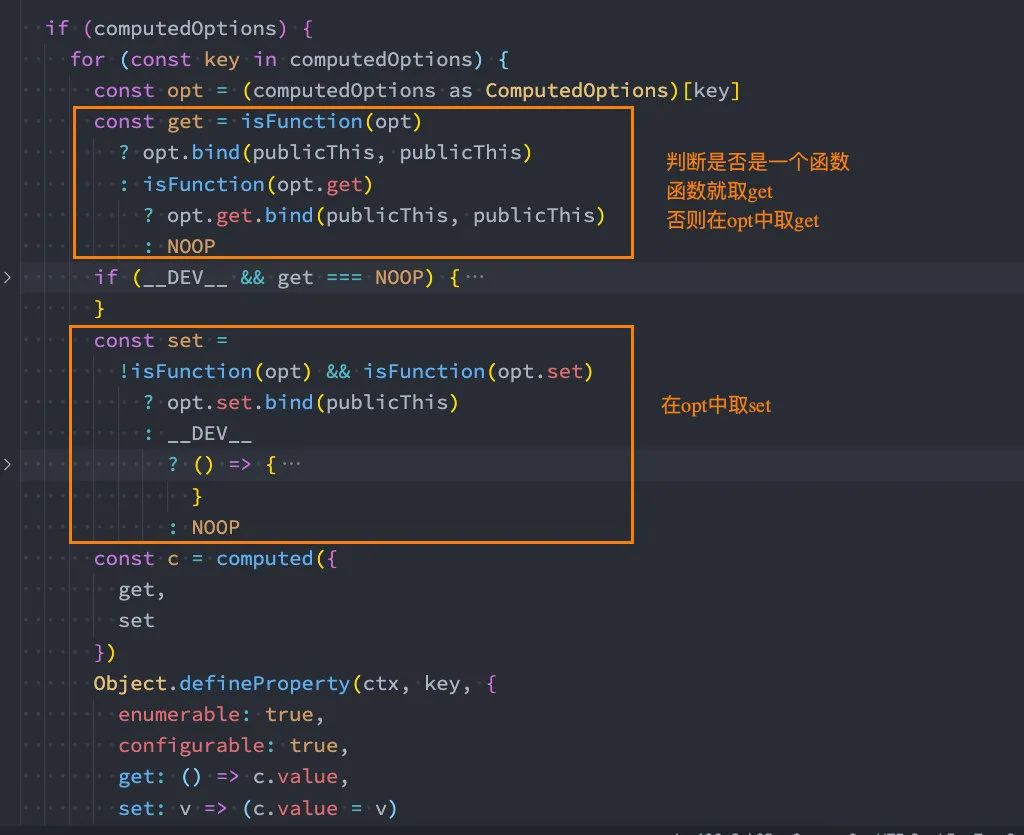
1.2. 侦听器watch
1.2.1. 侦听器watch的基本使用
侦听器的用法如下:
-
**选项:**watch -
类型: { [key: string]: string | Function | Object | Array}
什么是侦听器呢?
-
开发中我们在data返回的对象中定义了数据,这个数据通过插值语法等方式绑定到template中; -
当数据变化时,template会自动进行更新来显示最新的数据; -
但是在某些情况下,我们希望在代码逻辑中监听某个数据的变化,这个时候就需要用侦听器watch来完成了;
举个栗子(例子):
-
比如现在我们希望用户在input中输入一个问题; -
每当用户输入了最新的内容,我们就获取到最新的内容,并且使用该问题去服务器查询答案; -
那么,我们就需要实时的去获取最新的数据变化;
<div id="app"></div>
<template id="my-app">
<label for="question">
请输入问题:
<input type="text" id="question" v-model="question">
</label>
</template>
<script src="../js/vue.js"></script>
<script>
const App = {
template: '#my-app',
data() {
return {
question: "",
info: {
name: "why"
}
}
},
watch: {
question(newValue, oldValue) {
this.getAnwser(newValue);
}
},
methods: {
getAnwser(question) {
console.log(`${question}的问题答案是哈哈哈哈`);
}
}
}
Vue.createApp(App).mount('#app');
</script>
1.2.2. 侦听器watch的配置选项
我们先来看一个例子:
-
当我们点击按钮的时候会修改info.name的值; -
这个时候我们使用watch来侦听info,可以侦听到吗?答案是不可以。
<div id="app"></div>
<template id="my-app">
<button @click="btnClick">修改info</button>
</template>
<script src="../js/vue.js"></script>
<script>
const App = {
template: '#my-app',
data() {
return {
info: {
name: "why"
}
}
},
watch: {
info(newValue, oldValue) {
console.log(newValue, oldValue);
}
},
methods: {
btnClick() {
this.info.name = "kobe";
}
}
}
Vue.createApp(App).mount('#app');
</script>
这是因为默认情况下,watch只是在侦听info的引用变化,对于内部属性的变化是不会做出相应的:
-
这个时候我们可以使用一个选项deep进行更深层的侦听; -
注意前面我们说过watch里面侦听的属性对应的也可以是一个Object;
watch: { info: { handler(newValue, oldValue) { console.log(newValue, oldValue); }, deep: true }}
还有另外一个属性,是希望一开始的就会立即执行一次:
-
这个时候无论后面数据是否有变化,侦听的函数都会有限执行一次;
watch: { info: { handler(newValue, oldValue) { console.log(newValue, oldValue); }, deep: true, immediate: true }}
1.2.3. 侦听器watch的其他方式
我们直接来看官方文档的案例:
const app = Vue.createApp({ data() { return { a: 1, b: 2, c: { d: 4 }, e: 'test', f: 5 } }, watch: { a(val, oldVal) { console.log(`new: ${val}, old: ${oldVal}`) }, // 字符串方法名 b: 'someMethod', // 该回调会在任何被侦听的对象的 property 改变时被调用,不论其被嵌套多深 c: { handler(val, oldVal) { console.log('c changed') }, deep: true }, // 该回调将会在侦听开始之后被立即调用 e: { handler(val, oldVal) { console.log('e changed') }, immediate: true }, // 你可以传入回调数组,它们会被逐一调用 f: [ 'handle1', function handle2(val, oldVal) { console.log('handle2 triggered') }, { handler: function handle3(val, oldVal) { console.log('handle3 triggered') } } ] }, methods: { someMethod() { console.log('b changed') }, handle1() { console.log('handle 1 triggered') } }})
另外一个是Vue3文档中没有提到的,但是Vue2文档中有提到的是侦听对象的属性:
'info.name': function(newValue, oldValue) { console.log(newValue, oldValue);}
还有另外一种方式就是使用 $watch 的API:
-
我们可以在created的生命周期(后续会讲到)中,使用 this.$watchs 来侦听; -
第一个参数是要侦听的源; -
第二个参数是侦听的回调函数callback; -
第三个参数是额外的其他选项,比如deep、immediate;
created() { this.$watch('message', (newValue, oldValue) => { console.log(newValue, oldValue); }, {deep: true, immediate: true})}
二. 阶段案例
2.1. 案例介绍
现在我们来做一个相对综合一点的练习:书籍购物车
案例效果如下:
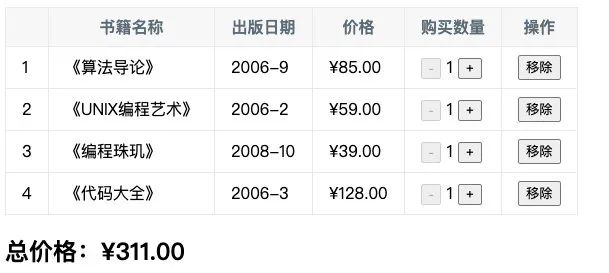
案例说明:
-
1.在界面上以表格的形式,显示一些书籍的数据; -
2.在底部显示书籍的总价格; -
3.点击+或者-可以增加或减少书籍数量(如果为1,那么不能继续-); -
4.点击移除按钮,可以将书籍移除(当所有的书籍移除完毕时,显示:购物车为空~);
2.2. 项目搭建
2.2.1. 模板引擎的搭建
我们先来搭建一下模板引擎:
-
它需要一个table来包裹需要展示的书籍内容; -
需要一个h2元素用于计算商品的总价格;
在这里我们有一些数据和方法需要在组件对象(createApp传入的对象)中定义:
-
比如book的数据; -
formatPrice、decrement、increment、handleRemove的方法等;
<template id="my-app"> <table> <thead> <tr> <th></th> <th>书籍名称</th> <th>出版日期</th> <th>价格</th> <th>购买数量</th> <th>操作</th> </tr> </thead> <tbody> <tr v-for="(item, index) in books" :key="item.id"> <td>{{index + 1}}</td> <td>{{item.name}}</td> <td>{{item.date}}</td> <td>{{formatPrice(item.price)}}</td> <td> <button @click="decrement(index)">-</button> {{item.count}} <button @click="increment(index)">+</button> </td> <td> <button @click="handleRemove(index)">移除</button> </td> </tr> </tbody> </table> <h2>总价: {{formatPrice(totalPrice)}}</h2> </template>
2.2.2. css样式的实现
为了让表格好看一点,我们来实现一些css的样式:
table { border: 1px solid #e9e9e9; border-collapse: collapse; border-spacing: 0;}th, td { padding: 8px 16px; border: 1px solid #e9e9e9; text-align: left;}th { background-color: #f7f7f7; color: #5c6b77; font-weight: 600;}
2.2.3. 代码逻辑的实现
接下来我们来看一下代码逻辑的实现:
const App = { template: '#my-app', data() { return { books: [ { id: 1, name: '《算法导论》', date: '2006-9', price: 85.00, count: 1 }, { id: 2, name: '《UNIX编程艺术》', date: '2006-2', price: 59.00, count: 1 }, { id: 3, name: '《编程珠玑》', date: '2008-10', price: 39.00, count: 1 }, { id: 4, name: '《代码大全》', date: '2006-3', price: 128.00, count: 1 }, ] } }, computed: { filterBooks() { return this.books.map(item => { item.price = "¥" + item.price; return item; }); }, totalPrice() { return this.books.reduce((preValue, item) => { return preValue + item.price * item.count; }, 0) } }, methods: { formatPrice(price) { return "¥" + price; }, decrement(index) { this.books[index].count--; }, increment(index) { this.books[index].count++; }, handleRemove(index) { this.books.splice(index, 1); } }}Vue.createApp(App).mount('#app');
2.2.4. 小的细节补充
这里我们补充一个小的细节,当我们的数量减到1的时候就不能再减了:
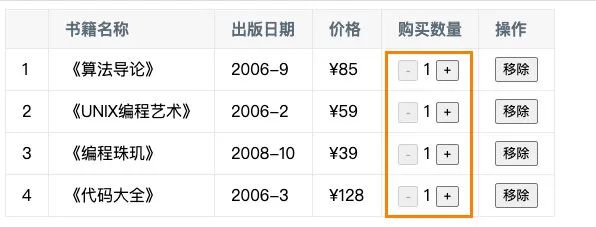
这里我们可以对button进行逻辑判断:
-
当item.count的数量 <=1的时候,我们可以将disabled设置为true;
<button @click="decrement(index)" :disabled="item.count <= 1">-</button>
三. 表单输入
3.1. v-model基本用法
表单提交是开发中非常常见的功能,也是和用户交互的重要手段:
-
比如用户在登录、注册时需要提交账号密码; -
比如用户在检索、创建、更新信息时,需要提交一些数据;
这些都要求我们可以在代码逻辑中获取到用户提交的数据,我们通常会使用v-model指令来完成:
-
v-model指令可以在表单 input、textarea以及select元素上创建双向数据绑定; -
它会根据控件类型自动选取正确的方法来更新元素; -
尽管有些神奇,但 v-model本质上不过是语法糖,它负责监听用户的输入事件来更新数据,并在某种极端场景下进行一些特殊处理;
<div id="app"></div> <template id="my-app"> <input type="text" v-model="message"> <h2>{{message}}</h2> </template> <script src="../js/vue.js"></script> <script> const App = { template: '#my-app', data() { return { message: "Hello World" } } } Vue.createApp(App).mount('#app'); </script>

3.2. v-model的原理
官方有说到,v-model的原理其实是背后有两个操作:
-
v-bind绑定value属性的值; -
v-on绑定input事件监听到函数中,函数会获取最新的值赋值到绑定的属性中;

事实上v-model的原理会比上面的更加复杂:
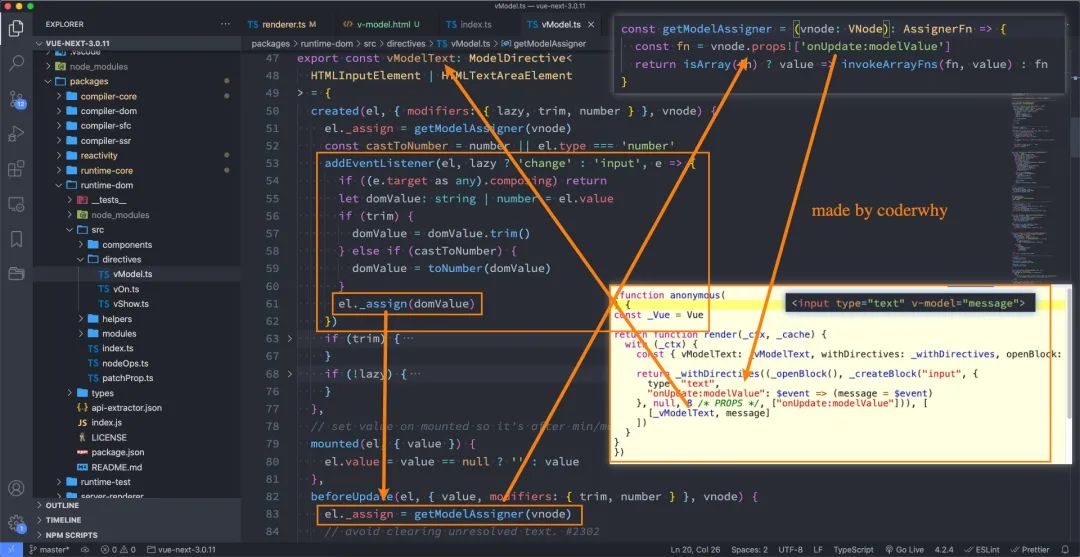
3.3. v-model绑定其他
我们再来绑定一下其他的表单类型:textarea、checkbox、radio、select
<div id="app"></div> <template id="my-app"> <!-- 1.绑定textarea --> <div> <textarea v-model="article" cols="30" rows="10"></textarea> <h2>article当前的值是: {{article}}</h2> </div> <!-- 2.绑定checkbox --> <!-- 2.1.单选框 --> <div> <label for="agreement"> <input id="agreement" type="checkbox" v-model="isAgree">同意协议 </label> <h2>isAgree当前的值是: {{isAgree}}</h2> </div> <!-- 2.2.多选框 --> <div> <label for="basketball"> <input id="basketball" type="checkbox" value="basketball" v-model="hobbies">篮球 </label> <label for="football"> <input id="football" type="checkbox" value="football" v-model="hobbies">足球 </label> <label for="tennis"> <input id="tennis" type="checkbox" value="tennis" v-model="hobbies">网球 </label> <h2>hobbies当前的值是: {{hobbies}}</h2> </div> <!-- 3.绑定radio --> <div> <label for="male"> <input type="radio" id="male" v-model="gender" value="male">男 </label> <label for="female"> <input type="radio" id="female" v-model="gender" value="female">女 </label> <h2>gender当前的值是: {{gender}}</h2> </div> <!-- 4.绑定select --> <div> <select v-model="fruit"> <option disabled value="">请选择喜欢的水果</option> <option value="apple">苹果</option> <option value="orange">橘子</option> <option value="banana">香蕉</option> </select> <h2>fruit当前的值是: {{fruit}}</h2> </div> </template> <script src="../js/vue.js"></script> <script> const App = { template: '#my-app', data() { return { article: "Hello World", isAgree: false, gender: "male", fruit: "" } } } Vue.createApp(App).mount('#app'); </script>
3.4. v-model的值绑定
目前我们在前面的案例中大部分的值都是在template中固定好的:
-
比如gender的两个输入框值male、female; -
比如hobbies的三个输入框值basketball、football、tennis;
在真实开发中,我们的数据可能是来自服务器的,那么我们就可以先将值请求下来,绑定到data返回的对象中,再通过v-bind来进行值的绑定,这个过程就是值绑定。
这里不再给出具体的做法,因为还是v-bind的使用过程。
3.5. v-model的修饰符
v-model在使用的时候可以在后面跟一些修饰符,来完成一些特殊的操作。
3.5.1. lazy修饰符
lazy修饰符是什么作用呢?
-
默认情况下,v-model在进行双向绑定时,绑定的是 input事件,那么会在每次内容输入后就将最新的值和绑定的属性进行同步; -
如果我们在v-model后跟上lazy修饰符,那么会将绑定的事件切换为 change事件,只有在提交时(比如回车)才会触发;
<template id="my-app"> <input type="text" v-model.lazy="message"> <h2>{{message}}</h2> </template>
3.5.2. number修饰符
我们先来看一下v-model绑定后的值是什么类型的:
-
message总是string类型,即使在我们设置type为number也是string类型;
<template id="my-app"> <!-- 类型 --> <input type="text" v-model="message"> <input type="number" v-model="message"> <h2>{{message}}</h2> </template> <script src="../js/vue.js"></script> <script> const App = { template: '#my-app', data() { return { message: "" } }, watch: { message(newValue) { console.log(newValue, typeof newValue); } } } Vue.createApp(App).mount('#app'); </script>
如果我们希望转换为数字类型,那么可以使用 .number 修饰符:
<template id="my-app"> <!-- 类型 --> <input type="text" v-model.number="score"> </template>
另外,在我们进行逻辑判断时,如果是一个string类型,在可以转化的情况下会进行隐式转换的:
-
下面的score在进行判断的过程中会进行隐式转化的;
const score = "100";if (score > 90) { console.log("优秀");}
3.5.3. trim修饰符
如果要自动过滤用户输入的首尾空白字符,可以给v-model添加 trim 修饰符:
<template id="my-app"> <input type="text" v-model.trim="message"> </template>
3.6. v-model组件使用
v-model也可以使用在组件上,Vue2版本和Vue3版本有一些区别,具体的使用方法,后面讲组件化开发再具体学习。
文章评论